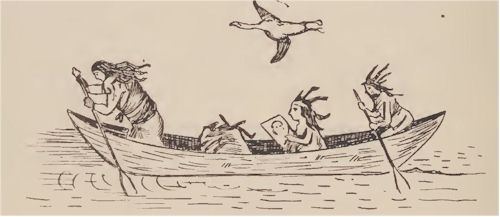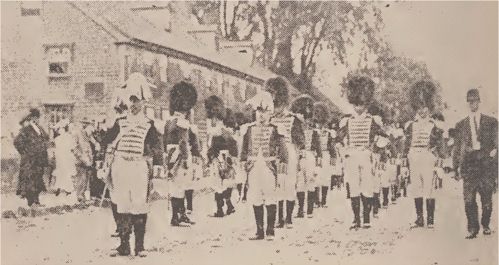Arnold's Trail
If you were asked, "Who was Benedict
Arnold?" your answer would be, "He was a traitor." The perfidy
of Arnold, the traitor, has blotted out all memory of Arnold,
the patriot; yet patriot he once was and model soldier. As an
able leader he stood high in Washington's esteem.
In 1775 Washington appointed Arnold
commander of an expedition against Quebec. He advanced by way of
the Kennebec River over the mountains of Maine, with a force of
eleven hundred men. These men were hunters and Indian fighters.
They knew how to procure food from the forests and fish from the
rivers and how to manage birch bark canoes. Their clothes were
made of deer skins. Each man carried a rifle, a long knife, a
small axe and a tomahawk.
They assembled at Prospect Hills, Mass., September 11th, 1775,
and sailed from Newburyport on the Merrimac River, on the
afternoon of September 19th, 1775. There were ten schooners and
sloops. After a smooth voyage, they entered the mouth of the
Kennebec one morning a little after sunrise.
Arnold worked his way four miles upriver
to Parker's Flat, where his vessel anchored for a few hours.
Then lie proceeded six miles up the river. Making its way among
rocks, islands and bays the fleet became scattered. Sailing
through Merrymeeting Bay, they pushed on toward Gardinerstown,
arriving Friday, September 22d. Arnold halted there to obtain
bateaux from Major Reuben Colburn's ship-yard.
Washington had ordered the building of
two hundred four-oared bateaux, each to be equipped with two
paddles and two setting poles. The bateaux were quickly but not
well made, as they were to be abandoned within a few weeks and
the need of staunch boats was not appreciated.
Major Colburn had been ordered by
Washington to send scouts over the route. Dennis Getchell and
Samuel Berry of Vassalboro performed this service. They reported
to Arnold that his advance was being watched by Indian spies
employed by Governor Carleton. Yet the expedition proceeded and
farther up the river Arnold was told by a squaw that at
Shettican the Mohawks were ready to destroy them.
When shoal water was reached they
transferred to the bateaux and thus moved on toward Fort Western
in the Augusta of today, the Hallo well of 1775, the Cushnoc of
Indian geography, forty-three miles from the sea. The whole of
Arnold's army arrived there before Sunday, September 24th.
Aaron Burr, afterward Vice-President of
the United States, was a private in this expedition. At Fort
Western he met Jacataqua, a beautiful princess of the Abnaki
tribe, who was eager to go with the soldiers to Quebec.
Before leaving the Fort a great feast
was spread. Jacataqua and Aaron Burr had killed a bear and two
cubs in Captain Howard's cornfield and these were roasted for
the banquet. Around them were arranged ten baskets of roasted
ears of corn with quantities of pork, bread and potatoes, one
hundred pumpkin pies, watermelons and wild cherries. William
Gardiner of Cobbosseecontee, Major Colburn and Squire Oakman of
Gardinerstown, Judge Bowman, Colonel Cushing, Captain Goodwin
and Squire Bridge of Pownalborough, with their ladies, were
invited guests. Led by the company officers, the troops and
guests marched to the table. Judge Howard was at the head of the
table, Jacataqua on his right and Aaron Burr on his left, with
General Arnold at the foot. Reverend Samuel Spring asked the
blessing, praying that Jacataqua might influence her people of
the wilderness to give them safe conduct along the march.
Later this maiden, being a great
huntress, scoured the forests for food for the starving
soldiers. Skilled in the use of herbs and roots, she faithfully
nursed those who fell ill.
On resuming the journey the troops found
the river half a mile beyond Fort Western blocked by the falls.
On the east side was a seldom travelled road to Fort Halifax,
and over this the country people with their oxen and horses
carried the bateaux and stores to Fort Halifax.
From this point part of the force
proceeded by water, the remainder by land. Half a mile above
Fort Halifax, they came to the first carry around Ticonic Falls.
This was accomplished by hard labor. A little beyond came the
dangerous Five Miles Ripples. Then the expedition reached
Canaan, now Skowhegan, where they had dinner. Next came a battle
with the Skowhegan falls. Here, between two ledges, forming a
passage only twenty-five feet wide, the river drives like a mill
race. With difficulty the bateaux were hauled through this
gate-way. On the succeeding long run of swift current, the men
walked on the banks drawing the boats by the painters, while
others pulled them from the rocks. Then they came to another
fall twenty-two feet high, which they passed with difficulty.
The troops were very tired and very glad
when they reached Norridgewock. They remained there a week to
repair the boats and refit the expedition.
Carratunk was the entrance to the real
wilderness. Arnold reached the Great Carrying place there
October 11th, the army in good health and spirits. Rain set in.
Because of inadequate shelter some few were taken ill and by
Arnold's direction a hospital was built which was immediately
occupied by Dr. Irvin with his patients.
Resuming the journey, Arnold wrote
Washington the greatest difficulties were passed and he hoped to
reach the Chaudiere in eight or ten days. The difficulties of
the road increased this time, somewhat.
Arnold entrusted to two Indians a letter
to John Manier, or Captain William Gregory or Mr. John Maynard,
Quebec, saying that he was on Dead River, one hundred and sixty
miles from Quebec, with about two thousand men, and that he
designed to cooperate with General Schuyler and assist the
Canadians in resisting Great Britain's unjust measures. The
letter asked the number of troops and vessels at Quebec.
Enclosed was a letter to General Schuyler asking for advices
from him. The letter fell into the hands of the
Lieutenant-Governor of Canada. This was the first they knew of
Arnold's detachment.
Eight miles from Bog Brook the
expedition came to Hurricane Falls, and another carry. A few
miles beyond in a clearing stood the cabin of Natanis, the
Indian, where is now the village of Flagstaff. The store of
provisions being very low, all men unfit for duty were sent
back.
October 19th rain began, resulting in a
disastrous flood. Dead River which drains many ponds suddenly
swelled. In nine hours it rose eight feet. At four o 'clock,
when Arnold and his party awoke, they found their baggage in the
flood.
 |
| The Flight of Nitanis |
Part of a Letter in the Indian Picture
Writing on Birch Bark, supposed to have been written by the
Norridgewock chief, Nitanis, informing his clansman of his
escape from the perils of Arnold's expedition against Quebec,
October, 1775. It was found in an Indian trail, in the
wilderness of the Upper Kennebec.
The weather grew cold and the soldiers
had no protection but tree boughs. Many boats were under water
and the landmarks were altered. Soldiers by land or water fared
hard, yet they pushed on to Black Cap rapids and the next
carrying place, Ledge Falls.
The next obstruction was Upper Shadagee
Falls, a sharp pitch followed by a long stretch of swift water.
Here the river makes a double turn around the cliff. In passing
this five or six bateaux filled and sank. Near the Falls Arnold
camped for the night and the next day resumed the journey. On
October 24th, he came to Serampos Falls, where he spent the
night. It rained and snowed, but they went on, resolved to
perish rather than give up the expedition.
They now passed into Chain of Ponds,
Long, Natanis and Round, from the last of which they were
puzzled to find an exit, but finally discovered one in Horse
Shoe Stream.
They were forced to halt and when they
lay down to sleep knew not whether they were on the right or
wrong way. In the morning no easy portage could be found, yet
they moved on, carrying from pond to lake, till the shaky boats
were placed in Moosehorn or Arnold, largest and most beautiful
of all the ponds in that region.
Now began the long portage over the
height of land. They encamped in the meadows, by Arnold's River,
to wait for the rear division of the army.
The report reached them that the
Canadians would supply them with food and that there were few
regulars at Quebec to resist them.
After issuing a note of cheer and
instruction to his men, Arnold rode three miles farther to a
house of bark on the eastern shore of Lake Megantic and encamped
for the night. Next morning he set out with four bateaux and a
birch bark canoe, for the outlet of the lake, the Chaudiere
River, a boiling, foaming stream.
There Arnold's party was in great
danger. Only the best boats could defy the water and avoid the
rocks. Two boats were destroyed and three others damaged but no
lives lost. At Sertegan, provisions awaited them. The people
showed good will and admiration for the courage of the
Americans. It was hard to find lodging. Huts were put up and
fires built, but the soldiers were very uncomfortable; for the
weather was cold and it snowed all day and night.
 |
Second Company, Governor's Foot
Guard,
of New Haven, Conn. |
On August 18th, 1912, The Second
Company, Governor's Foot Guard, of New Haven, Conn., founded in
1774, and one of the most famous military organizations in
America, started a pilgrimage to Quebec, following the route
through Maine, taken by Benedict Arnold on his famous expedition
to Canada. An incident of this pilgrimage was the dedication of
a boulder monument at Fort Western, Augusta, where 137 years
before, Arnold's forces halted for a week on their memorable
march. The boulder was erected to the memory of the Connecticut
men who followed Arnold to Canada. The above picture was taken
at Augusta, on that memorable occasion. Fort Western is seen at
the left of the picture.
Arnold's messenger was captured. Then
came rumors that the approach of the Provincials was known to
the enemy; that the river was guarded by a frigate and a sloop
of war, and that the inhabitants in the vicinity of Quebec had
been summoned to the defense of the city under the penalty of
death.
Still Arnold kept at work; he collected
provisions and more boats, even made plans to scale the walls.
November 13th, in the inky blackness of night, three trips
across the river were made and five hundred men were landed on
the north side. Then the tide ebbed, exposing the rocks, and the
wind blew, preventing the crossing of more troops. The moon
appeared and the Americans on the north shore were discovered.
Arnold's venture was a failure. His march was over.
Mrs. E. C. Carll
|
![]()
![]()